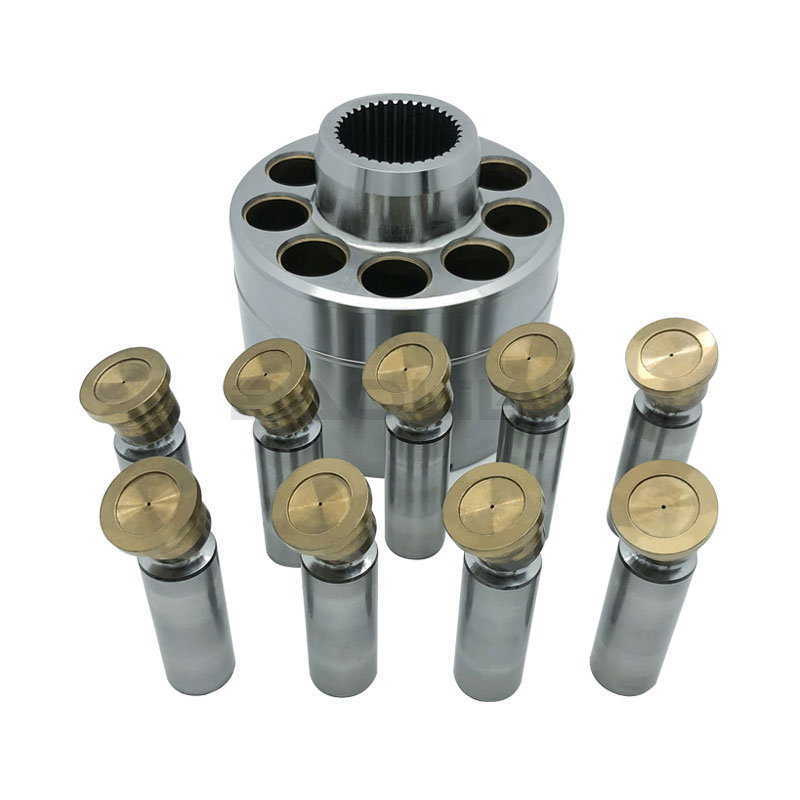The principle of piston movement in axial piston pumps
The principle of piston movement in axial piston pumps
Axial piston pumps have multiple pistons (usually an odd number), some of which are mounted in an annular array in a housing often called a cylinder, rotor, or jane. The cylinder is driven around its symmetrical axis by virtue of an integral shaft that is more or less aligned (often parallel but not) with the pumping piston. Mating surfaces. One end of the cylinder is raised and worn on a mating surface on a fixed valve plate. The pump inlet and outlet fluids differ by virtue of the cylinder and valve plate moving at different parts of the interface with each other. The valve plate has two curved interfaces that support the entry of working fluid to and exit of fluid from the outlet, respectively. The more prominent piston. The pumping piston protrudes from the corresponding end of the cylinder. There are also many configurations used as the exposed end of the piston, but these ride on the cam during the process. In variable displacement units, the cams are movable and are often called running swash plates, yokes or mounts. Beginning with the purposefulness of the concept, the cam is usually represented by a plane, the orientation of which, in conjunction with the operation of the shaft, forms the cam action that triggers the reciprocating motion of the piston and thus the pumping. The angle between the vector vertical to the cam plane and the cylinder rotation axis, called the cam angle, is a variable that determines the movement of the pump or the amount of fluid rotated per rotation axis. Variable displacement units have the ability to change the cam angle during the application period, while fixed displacement units do not.

With a reciprocating piston, the exposed end of the piston is restricted to follow the surface of the cam plane when the cylinder is running. Given that the cam plane is at an angle to the axis of rotation, then the piston reciprocates axially as it feeds around the midline of the cylinder. The axial motion of the piston is sinusoidal. During the climbing part of the piston's reciprocating cycle, the piston moves toward the valve plate. At the same time, during this period, the fluid caught in the piston buried end and the valve plate between each other by virtue of a curved interface of the valve plate - discharge port to the pump discharge port. When the piston moves toward the valve plate, the fluid is propelled or moved using the discharge port of the valve plate. Interference of age difference. When the piston is located at the upper end of the reciprocating cycle (often referred to as the upper stop or TDC only), the connection between the squeezed fluid chamber and the pump discharge port is closed. Shortly after this, the same chamber is open to the pump inlet. When the piston then continues to move around the cylinder midline, it avoids the valve plate movement, and therefore increases the volume of the squeezed chamber. In such a situation, fluid from the pump inlet into the chamber to fill the gap. This process continues until the piston reaches the bottom reciprocating cylinder - often referred to as the lower dead center or BDC. at BDC, the connection between the pump chamber and the inlet is closed. Shortly after this, the chamber opens again to the discharge and the pumping cycle starts again.
The selected hydraulic oil is cooled over time and passed through a micron filtration system, then circulated by virtue of the pump. Despite these problems, this type of pump can be integrated with most circuit controls (operating swashplate angle control) to regulate flow and pressure, is reliable, and support the rest of the hydraulic system is simple and inexpensive. The axial piston pump is used to drive the jet hydraulic system, driven by the main shaft gear of the turbine engine. 9 pistons are used in the program applied to the F-14, producing a standard system operating pressure of 3000 psi and a Zmax flow rate of 84 ppm/gallon. Vehicle refrigeration compressors used today for cabin cooling are primarily based on axial piston pumps designed to cope with their component space requirements and to dampen oscillations in the vehicle engine compartment. They can be used in fixed constant displacement and dynamically adjustable variable displacement variants. They are also suitable for some high-pressure cleaners. For example, several models are energized by an axial piston pump with three pistons. Axial reciprocating motors are also suitable for energizing numerous machines. They are used with the same principle as described above, leaving the circulating fluid supplied at very high pressure and the piston housing rotating and the shaft power supplied to another machine. A common use of axially reciprocating motors is to energize small civil construction projects.
This article is published by the official website of Baolilai Hydraulics, please contact the author and indicate the source for reprinting:https://www.baolilai-pump.cn/news/311.html






